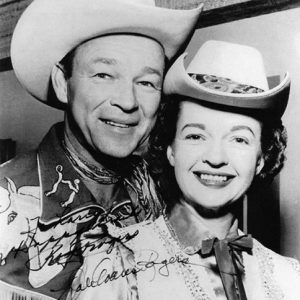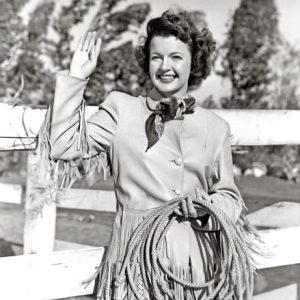calsfoundation@cals.org
Dale Evans (1912–2001)
aka: Frances Octavia Smith
Dale Evans was an actress, author, and songwriter who was raised in Osceola (Mississippi County), where she attended school for the first time and met her first husband. She rose to fame as America’s “Queen of the West” (sometimes called “Queen of the Cowgirls”) alongside her fourth husband, Roy Rogers (“King of the Cowboys”). She starred in movies, television shows, and evangelical Christian programs. Evans wrote twenty-eight inspirational books and composed many songs, including the popular song of faith, “The Bible Tells Me So,” as well as the iconic American standard, “Happy Trails.”
Dale Evans was born in her grandparents’ home at Uvalde, Texas, though her family lived in Italy, Texas. Her father, Walter Smith, was a middle-class farmer who also owned and operated a hardware store in the small town of Italy, which had about 1,000 residents. Her mother, Betty Sue Hillman Smith, was a homemaker. The evidence of her birth was an affidavit from her parents saying she was born Frances Octavia Smith on October 31, 1912, which she used for her driver’s license and passport until it was misplaced in 1954. Requesting a birth certificate from the Texas Bureau of Vital Statistics, she was surprised to see it in the name of Lucille Wood Smith, born on October 30. Her mother insisted that she was born Frances Octavia and that the record keepers were wrong, though even her mother was unsure of the date, so October 31 was officially adopted.
At the age of three, she made her gospel singing solo debut at the Baptist church in Italy. When she was seven, the family—including her younger brother, Hillman—moved to Osceola, after her father’s brother told stories of bountiful cotton fields in the Arkansas community. He failed to mention floods, boll weevils, and mosquitoes, and she later said the family’s first year in Arkansas was “neither financially rewarding nor joyous.” The next year was more successful.
After being taught the basics of reading, writing, and arithmetic by her mother, she entered school in Osceola for the first time at age seven. After spending a half year in the first grade, she was moved ahead to the third. She would also skip the seventh grade, arriving in the eighth grade at age eleven, at which point she suffered a nervous breakdown and was ordered to spend the summer in bed.
Even then, she took piano lessons, but her instructor quit, saying the child refused to practice her scales and instead improvised her own songs. She returned to school at age twelve as a freshman in high school. At a weekly public dance held at the courthouse, she met an older boy, Thomas Fox, and eloped with him at age fourteen. Lying about their ages, they were married at the home of a local minister in Blytheville (Mississippi County).
They moved to Memphis, Tennessee, where their son, Thomas Fox Jr., was born. She was seventeen when they were officially divorced in 1929, her husband believing that he was too young to be tied down to a wife and child.
In Memphis, she took courses in business school and worked as a secretary while aspiring to become a singer. After working at a bus company, she found a higher-paying job at an insurance agency, where her boss heard her singing at her desk. With his help, she found occasional work as a radio singer at WMC and WREC on programs sponsored by the insurance company. She became a local radio show regular under the names Frances Fox and Marian Lee.
(Some sources state that, in 1929 in Memphis, she married August Wayne Johns, divorcing in 1936. There were no children. In her autobiography, Happy Trails, she does not mention this union.)
Seeking a larger radio market, she moved with her son Tommy to Chicago, Illinois, in 1930, where she found few job prospects and was diagnosed with acute malnutrition. After recovering, she and Tommy moved to Louisville, Kentucky, where she found both a job at station WHAS and her final stage name. Station manager Joe Eaton renamed her Dale Evans because it was easy for radio announcers to pronounce. She gained popularity as a singer on the air and in clubs around Louisville.
However, her son became ill, and she decided to return to Texas so that he could stay with her parents, who had left Arkansas for their farm near the town of Italy. She found work as a singer at station WFAA in Dallas, joining her family in Italy on weekends. While in Texas, she heard from Robert Dale Butts, a pianist and orchestra leader she had known in Louisville. He moved to Dallas, also finding work at WFAA, and they were married in 1937.
With her son staying with her parents, the couple moved to Chicago, where Butts found work with the local NBC radio affiliate and she found singing jobs with big bands. One such engagement with the Anson Weeks Orchestra took her on a cross-country tour that lasted a year, including eight weeks in Los Angeles, California. There were no immediate job offers there, but after the two returned to Chicago, she was invited by Hollywood agent Joe Rivkin to do a screen test for the movie Holiday Inn (released in 1942) with Bing Crosby and Fred Astaire. While she did not win the part, Rivkin became her agent, subtracting seven years from her age. He also told her to remove her wedding ring and changed some details of her biography, most notably promoting the story that Tommy was her younger brother, not her son.
By 1942, Evans was signed to a one-year contract by 20th Century Fox and appeared in the films Orchestra Wives and Girl Trouble that same year. She became a regular on the Edgar Bergen radio show broadcast nationally from Hollywood, and she joined a USO troupe during World War II.
Moving from Fox to Republic Pictures, she worked in such western films as In Old Oklahoma (1943) opposite John Wayne. In 1944, The Cowboy and the Senorita paired her with cowboy star Roy Rogers (born Leonard Franklin Slye). They proved a popular pair and continued to co-star in such films as Yellow Rose of Texas (1944), Lights of Old Santa Fe (1944), and Utah (1945).
The acting team of Rogers and Evans was a success. Off screen, in 1945, Dale Evans was divorced from her husband, and the next year, Rogers’s wife, Arlene Wilkins Rogers, died of an embolism one week after giving birth to their son, Roy Rogers Jr. (called Dusty). On December 31, 1947, Rogers and Evans were married at the Flying L Ranch near Davis, Oklahoma, where they had just completed filming Home in Oklahoma. After their wedding, they ended the falsehood about Tommy being Dale’s brother and acknowledged him as her son.
In addition to Dale’s son and Roy’s children (Cheryl, Linda Lou, and Dusty from his marriage to Arlene), the couple had a daughter, Robin Elizabeth Rogers, on August 26, 1950. Robin died two years later of complications of Down’s Syndrome, inspiring Dale to write a book in her honor, Angel Unaware. The couple became foster and adoptive parents to other special needs children: Dodie; Marion; Deborah Lee, who died in a bus accident at age twelve; and John David (Sandy), who died in an accident while in the peacetime army in Germany. To honor their lives, Evans wrote the books Dearest Debbie and Salute to Sandy.
In 1950, Dale Evans wrote the song, “Happy Trails,” which Roy Rogers used as his theme song. Writing the lyrics on an envelope, she taught the melody to Rogers and the singing group, Sons of the Pioneers, only minutes before their radio show.
The couple made thirty-five films together and founded their own production company, Roy Rogers Productions. They created The Roy Rogers Show (1951–1957), The Roy Rogers and Dale Evans Show (1962), and Happy Trails Theatre (1986–1989). In 1973, they appeared in a television special called Saga of Sonora. In 1968, Roy Rogers licensed his name to a restaurant chain whose creators chose him as their namesake for his all-American wholesomeness; there were more than 600 restaurants at the chain’s peak, many of which hosted personal appearances by Evans and Rogers.
Evans starred in her own weekly Christian TV program, A Date with Dale, from 1996 until her death in 2001. The couple owned a ranch in Apple Valley, California, and founded the Roy Rogers–Dale Evans Museum in nearby Victorville, where they often greeted fans. In 2003, the museum moved to Branson, Missouri, where the Roy Rogers Jr. family was involved in the daily operations of the 26,000-square-foot museum and the Happy Trails Theater, featuring live performances by Roy Rogers Jr. On October 6, 2009, the owners announced that the operation would close in December 2009 due to the economic downturn as well as declining attendance. The memorabilia formerly displayed there was sold in 2010.
Evans holds two stars on the Hollywood Walk of Fame, was inducted into the Texas Country Music Hall of Fame (2000) and the Cowgirl Hall of Fame (1995), and received the Cardinal Terrence Cook Humanities Award (1995).
After more than fifty years of marriage to Evans, Rogers died of heart failure in 1998. Evans died of heart failure on February 7, 2001. She was survived by six children, sixteen grandchildren, thirty-two great-grandchildren, and six great-great-grandchildren. She is buried beside Rogers at Sunset Hills Memorial Park in Apple Valley, California. Her work continues through the Roy Rogers–Dale Evans Happy Trails Foundation for abused children, which sponsors the annual Roy Rogers–Dale Evans Western Film Festival, which began in 1998, near their former ranch in California.
For additional information:
Enss, Chris, and Howard Kazanjian. The Cowboy and the Senorita. Guilford, CT: Falcon Press, 2004.
Rogers, Dale Evans. Rainbow on a Hard Trail. Tarrytown, NY: Revell Books, 1999.
Rogers, Dale Evans, and Roy Rogers, with Carlton Stowers. Happy Trails: The Story of Roy Rogers and Dale Evans. Waco, TX: Word Books, 1979.
White, Raymond. King of the Cowboys, Queen of the West: Roy Rogers & Dale Evans. Madison: University of Wisconsin Press, 2006.
Nancy Hendricks
Arkansas State University
 Dale Evans with Roy Rogers
Dale Evans with Roy Rogers  Dale Evans
Dale Evans 




Comments
No comments on this entry yet.